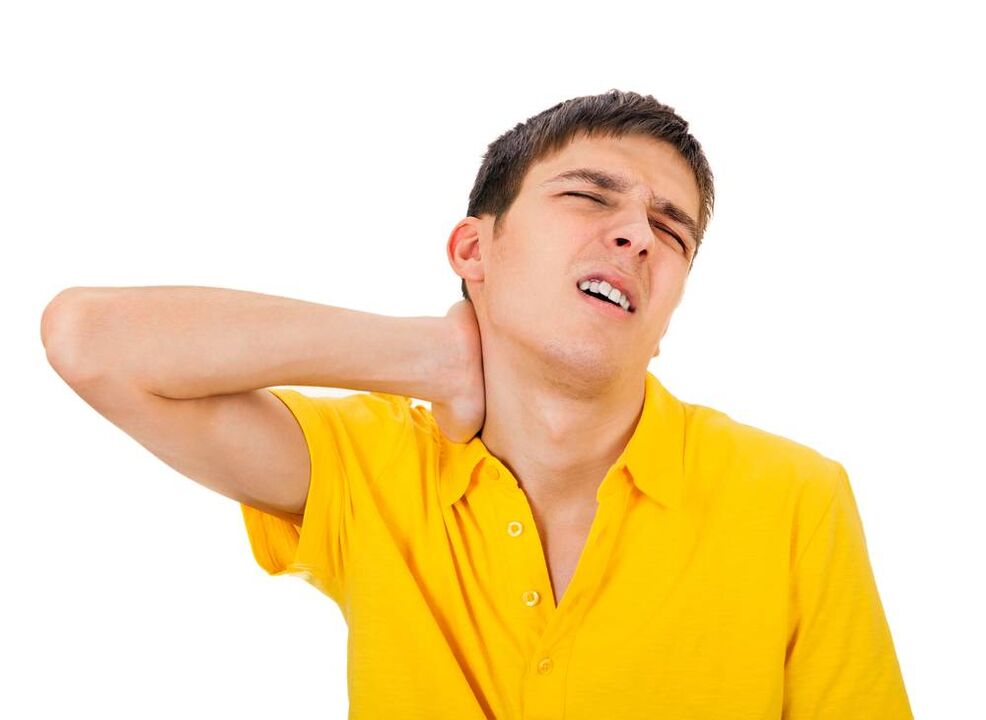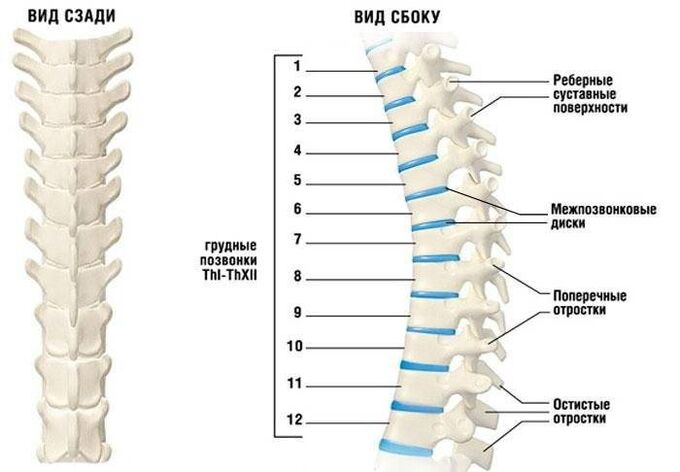According to medical statistics, almost all people over 25-30 years are complaining about the symptoms of cervical osteochondrosis.The disease affects this spine more often than others.The pathology is a progressive degenerative process affecting the intervertebral discs and vertebrae located in the neck.The disease is common among men and women.It is a dangerous and complex form of osteochondrosis as large blood vessels that supply the brain and a large number of nerve endings are located in the neck.Disorders of innervation and blood flow lead to a deterioration in the brain to oxygen and nutrients.

Signs of the disease
Symptoms of osteochondrosis of the cervical spine are more pronounced than in other parts of the spine, even with minor damage.This is due to the fact that the vertebrae are located close to each other in the neck and the intervertebral discs are low in height.A similar anatomical characteristic contributes to the fact that with osteochondrosis, nerve endings, spinal cord, blood vessels are compressed more frequently.
Common symptoms:
- pain syndrome;
- weakness and reduction of sensitivity in the upper limbs;
- limiting neck mobility;
- disorders of movement coordination;
- often dizziness;
- general weakness;
- Deterioration of the functioning of the organs of perception (hearing, vision, touch, taste).
The pain is more often localized in the neck, they give them to the back of the head, shoulders, hands.The upper limbs hurt if the nerve spine is pressed by the damaged vertebra that is responsible for their innervation.The pain in the back of the head is due to spastic contractions of the neck muscles attached to the occipital bones and a disorder of the circulation in this area.
The weakness of the hands is observed in patients if the nerve spine is involved in the pathological process that guarantees the innervation of the muscular structures of the upper limbs.The restoration of mobility and a characteristic crisis, when the neck rotates or tilts, occurs if the bones appear on the cervical vertebrae, the height of the intervertebral discs is reduced, the joints located between the vertebrae are affected.
The vertebrae in the neck have transverse processes that form a canal in which the artery that feeds the brain.With osteochondrosis of the cervical spine, the vertebrae are displaced, the connective tissue grows on them.This leads to compression of the cervical artery, worsening of the blood supply to the brain and the back of the brain.As a result, a person has often dizziness, movement coordination, general weakness is disturbed.In advanced cases, if the artery is involved in the pathological process or severely pushed, then the delivery of blood from the brain, the back and the brain stem deteriorates significantly.In this case, the functionality of the hearing and vision organs, the tingling of the tongue and fingers decreases.
The signs of the disease depend on which of the eight vertebrae is influenced by a dystrophic or inflammatory process.Sensitivity and movement disorders lead to damage to the cerebrospinal roots that affect certain vertebrae.Depending on this, the following manifestations of cervical osteochondrosis are observed:

- The first vertebra - the neck and the back of the head are numb, their sensitivity decreases;
- The second - the pain in the crown and the nape is felt;
- The third - the pain is felt and the sensitivity is reduced in that part of the neck, where the drained spine is located, the intensity of the taste sensations decreases and the disorders of speech;
- The fourth pain radiates in the shoulder, the scapula, the patient is impaired by heart pain, respiratory disorders and the tone of the neck muscles decreases;
- Fifth - pain is observed in the neck given on the outer surface of the shoulder;
- The sixth - neck pain is radiated in the blade of the shoulder, felt in the forearm and thumbs;
- Seven - the pain is applied to the shoulder, the back of the shoulder, the forearm and the fingers (from the second to the fourth);
- Eighth - pain spread from neck to shoulders, forearms and little finger.
Depending on the spread of the lesion, four degrees osteochondrosis of the cervical spine differ.This is not the stage of the disease, but the severity of the symptoms, because how often the pathological process is, what the vertebrae influence.
- The first degree clinical symptoms are absent or manifesting minimal.Patients complain of mild pain, intensifying during head movements.Treatment that has started at this stage of the disease will be effective.However, people often ignore disturbing symptoms or do not feel them, so they do not consult a doctor.
- The worsening of the pathological process increases the symptoms.In the second stage, the pain becomes more pronounced, they give the upper limbs, the shoulder blades.At this stage of the development of the degenerative process, the height of the intervertebral disc is reduced, resulting in the nervous fiber pressed.This becomes a reason for an increase in pain.The second degree of osteochondrosis of the cervical region is characterized by the appearance of headaches, worsening in well -being, reduction of working ability.
- The third degree of cervical osteochondrosis is distinguished by the formation of hernia of the affected intervertebral discs.Neck mobility is limited, with palpation the patient experiences severe pain.With this spread of the pathological process, the pain becomes constant, radiating to the upper limbs.The tension of the muscles attached to the back bones is felt.Patients complain of frequent dizziness, general weakness, numbness of the hands.
- The fourth degree of cervical osteochondrosis is diagnosed when the intervertebral disc is completely destroyed by a dystrophic process.It is replaced by fibrous tissue, which leads to a significant limitation of mobility.They affect the spinal cord and blood vessels flying in the neck.Such changes are characterized by a significant deterioration of the blood supply to the cerebellum and the back of the brain.Oxidized hunger leads to impaired movement coordination, hearing impairment, vision, language, speech disorders.
Methods of treatment
Timely search for a doctor, when the first worrying symptoms occur, the unpleasant sensations in the neck, the reaction from the nervous system will prevent the progression of degenerative changes.The treatment of cervical osteochondrosis consists of a complex of therapeutic measures.Among them:
- administration of medicines;
- massage;
- Physiotherapy Physical Education;
- Physiotherapy procedures.
Drug therapy
Doctors prescribe anti -inflammatory drugs to reduce the intensity of pain, reduce the inflammatory process and swell the nerve spine.Chondroprotectors restore damaged cartilage tissue in the intervertebral disc.Mussorelaxants relax the muscles of the neck, relieve spasm.Medications to improve blood flow help to resume impaired brain blood supply.Vitamins from B activate metabolism in nerve tissues.With intense pain, the doctor may prescribe analgesic drugs.If the patient has a pronounced pain syndrome, then the analgesics are inserted into parenterally after the pain has disappeared, they go to tablets.
Physiotherapy
Physiotherapy is an effective way to combat osteochondrosis of the cervical region.It is mandatory to treat this disease with the help of such techniques, after which the following results are achieved:
- The intensity of pain decreases;
- The restoration of the affected bone, cartilage and muscle tissues is activated;
- Muscle spasm and tension are removed;
- the inflammatory process is stopped;
- The supply of oxygen and nutrients to the affected area and the brain improves.
The most effective in treating osteochondrosis are the following types of procedures:
- The electrophoresis of the drug (the affected area acts with electric shock, which in addition to activating blood flow and the repair of tissues improves the supply of the current substance to the drug to the tissues affected by a degenerative process);
- Ultrasound therapy (metabolic processes in the diseased area are activated, reduced pain, inflammation is stopped);
- Magnetotherapy (relieves swelling of the affected area, which helps reduce the intensity of pain);
- Laser therapy (improves blood circulation in the pathological process, has an anti -inflammatory effect).
Medical physical education
Exercises are prescribed during the period when the acute manifestations of the disease are stopped.During gymnastics, no discomfort and soreness should be felt.The complex must be carried out when permanent remission is reached to prevent relapse.

- Take a position lying on your stomach, lift your head and body, lean on your hands.The back is straight, the breath is deep and even.Hold in position for a minute or two, then slowly take the starting position.The number of repetitions is 3.
- The position lies on the stomach, the hands of the body.Slowly turn your head, trying to touch your ear to the floor.Repeat 6 times on each side.
- Sitting or standing, tilt your head on inhalation, trying to get to your chin to your chest.To exhale smoothly bring your head back, raising your eyes to the ceiling.The number of repetitions is 10-15.
- A good exercise to strengthen the cervical muscles is to press the forehead to the hands pressed against it.To achieve the effect, you need to press the palms on the forehead and forehead on the palm of your hand for 30 seconds.Repeat three times.
- Turn your head in a circle.Do the exercise slowly, smoothly.In each direction - 10 turns each.The appearance of dizziness during movements is unacceptable.If this happens, you should stop immediately.
Massage
The course is prescribed by a doctor during the lack of acute pain, only a specialist with medical education can conduct it.In such a disease, it is not recommended to contact non -professionals.
Therapeutic effects of the collar area massage:
- The blood flow and lymph in the affected area are improved;
- The muscles are relaxed, the spasm is removed;
- The intensity of pain decreases.
Surgery
The surgery is indicated if conservative therapy does not lead to results within six months, the patient is tormented by severe pain, monitors signs of nerve fiber damage and myelopathy.If osteochondrosis of the cervical region occurs with complications, there is a threat of stroke, there is a severe pressure on the spinal cord, then the surgery is necessary.
According to the indications, they resort to the following types of surgical interventions:
- Endoscopic discoctomy - removal of a part or entire intervertebral disc;
- Laminomy - cutting of bone ligaments and overgrown bone particles (often combined with laminoplasty - detection of artificial plates to enlarge the spinal canal);
- Laser evaporation of the core of the disc - the breakdown of the nucleus of the intervertebral disc with a laser beam at the same time as the destruction of its destroyed fragments;
- Cold -plasma nucleoplasty -Instead of the endoscope, a long and thin hollow needle is used, which is introduced into the intervertebral disc, with an electrode that has an effect paid in the cold.
The neck is a complex organ in which large blood vessels pass, the spinal cord.They are easy to damage, so they resort to surgery in no more than 5% of cases.Surgical treatment is often accompanied by the development of complications.Among them:
- inflammatory process in tissues or membranes of the spinal cord;
- osteomyelitis;
- The formation of scars leading to narrowing of the arterial and spinal canals.
Cervical spine operations are complex and require a long rehabilitation period.The patient's recovery after surgery takes a period of six months or more.
Prevention
To prevent the development of cervical osteochondrosis, it is necessary:
- Follow the position of the spine and neck;
- Lead an active lifestyle, move more;
- When exercising, care is necessary to monitor the correctness of the execution, as even minor injuries can affect the condition of the musculoskeletal system;
- Take care of the proper position of the body during sleep, buy an orthopedic or anatomical mattress;
- Properly equip a workplace where a person spends a lot of time;
- They regularly deal with physical culture;
- Follow the diet, guarantee the receipt of all the useful minerals needed for the bone fortress, especially magnesium and calcium;
- They are constantly undergoing dispensary examinations for the timely detection of osteochondrosis.
Prevention will help prevent degenerative changes in the cervical spine, prevents pain, dizziness, numbness of the limbs and other unpleasant symptoms.


















































